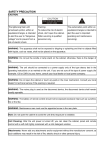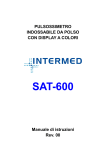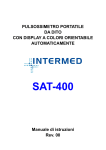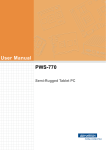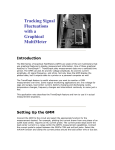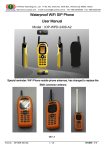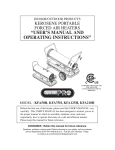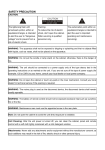Download PM-60A Instruction Manual
Transcript
CONTEC PM-60 A Pulse Oximeter PM-60A Users Users’’ Manual CONTEC The document including some secret information, belongs to Contec medical systems co. LTD., in which any information is not allowed to be transmitted, copied ,or disclosed to any other companies except the recipient ones, even not for other commercial purposes. Catalogue Catalogue…………………………………………………………………………………………...2 ………………………………………………………………………………………… .3 1 Preface Preface………………………………………………………………………………………… ………………………………………………………………………………………….3 1 2 3 4 5 6 1 .1 Caution Proceeding……………………………………………………………………….3 1 .2 Manipulator Obligation …………………..........................................................................3 The Basics...................................................................................................................................3 .................3 2.1 Introduction.........................................................................................................................3 2.1.1 Intended Use ..........................................................................................................4 2.1.2 Contraindications ...................................................................................................4 2.1.3 Components ...........................................................................................................4 2.2 Features……………………………………………………………………………………4 …………………………………………………………………… ... …..4 Main Technical Index Index…………………………………………………………………… ……………………………………………………………………... ...… 3.1 Performance Specifications………………………………………………………………..4 3.2 Technical specifications ……………………………………………………………. ……5 3.3 SPO2 ………………………………………………………………………………...........6 ………………………………………………………………………… Function Instructions Instructions………………………………………………………………………… …………………………………………………………………………66 4.1 Main interface……………………………………………………………………………..6 4.1.1 Composing parts………………………………………………………………….7 4.1.2 Function Button…………………………………………………………………..8 4.2 New patient information interface………………………………………………………...8 4.3 Data Review Interface……………………………………………………………….……9 4.3.1 Data Review Interface…………………………………………………………....9 4.3.2 TrendTable Interface…………………………………………………………….10 4.3.3 TrendGrape Interface……………………………………………………………10 4.3.4 AlarmReview and WaveReview Interface………………………………………11 4.4 Setup Interface………………………………………………………………………… ..11 4.4.1 Setup Interface………………………………………………….……………….11 4.4.2 System Setup…………………………………………………………..………..13 ………………………………………………………………… ..14 Maintenance and Cleaning Cleaning………………………………………………………………… …………………………………………………………………..14 5.1 Safety Checks………………………………………………………………………...….15 5.2 Cleaning………………………………………………………………………………….15 5.3 Disinfecting………………………………………………………………………………16 5.4 Disposal………………………………………………………………………………….16 …………………………………… ... ………………………… ... ………………… .17 Appendix Appendix…………………………………… ……………………………………... ...………………………… …………………………... ...………………… ………………….17 6.1 Alarm characters specification…………………………………………………………...17 6.2 Usual metrical range……………………………………………………………………..17 1 Preface This manual contains the instructions necessary to operate the product safely and 2 in accordance with its function and intended use. Observance of this manual is a prerequisite for proper product performance and correct operation and ensures patient and operator safety. This manual is based on the maximum configuration and therefore some contents may not apply to your product. If you have any question, please contact us. This manual is an integral part of the product. It should always be kept close to the equipment so that it can be obtained conveniently when needed. This specification includes all the functions and operation flow, some usual questions and detailed answers offered. Please read the specification carefully before using this product to smooth your usage . Thanks for using PM-60A Pulse Oximeter products and look forward to your valuable suggestions and advice. PM-60A Website: http://www.contecmed.com.cn 1.1 Caution Before usage, please be aware of safety and validity stated below: � The system should be used under doctors’ guide. � The reliability of the product depends on whether the operation and maintenance are properly done. ␇ Warning: system errors may arise if non-proper accessories are replaced; therefore, any maintenance men who haven’t been trained in our company or normal maintenance organization should not maintain this system. 1.2 Manipulator Obligation Caution: please read the user manual carefully before usage. Obligations of Contec Medical System Co. LTD. 1.Our company will resolve any software and hardware problems of the product in one year after your purchase with the precondition of proper usage of it. 2.Responsible for users' training. 3.Responsible for free update and life maintenance of the software. 4.Responsible for free maintenance of hardware after your purchase. 5. Not responsible for damage caused by improper usage or non-fixed accessories usage. 2 The Basics 2.1 Introduction 2.1.1 Intended Use The pulse oximeter is intended for continuously monitoring, spot checking, displaying, storing and printing oxygen saturation and pulse rate of single adult, pediatric and neonatal patient in hospital, emergency treatment and patient transport 3 as well as in home care environment. WARNING This pulse oximeter is intended for use only by clinical professionals or under their guidance. It must only be used by persons who have received adequate training in its use. Anyone unauthorized or untrained must not perform any operation on it. 2.1.2 Contraindications None. 2.1.3 Components This pulse oximeter consists of a main unit and a SpO2 sensor. 2.2 Features: Regular Check Mode and Continuous Monitoring Mode Data Graph and Trend Table Review Rich Analysis report Perfect mount solution Sync with PC based Sofrware (WinXP and WinVista) 3 M ain Technical Index 3.1 Performance Specifications Display: 3.5" Color TFT Resolution: 320 x 240 Display Mode: Standard face, Waveform face, Display Direction adjustable Indicator: Interface: Power indicator light, Alarm sound, Pluse tone One dual-purpose socket for connecting SPO2 sensors and communication Power Supply: Battery: cables DC 5V, <300MA Builtin Li-Polymer, 6 hours for charging, 9 hours for continous working. 12 hours for standby mode 3.7v,1900mah Trend Graph/Table: Resolution from 1s, 5s, 10s,30s,1min,and so on. Storage of latest 96 hours trend data. Second is the unit. 4 History: Storage of latest 10000 case history by SD card. Permit to review momentarily. Alarm: Ajustable High and Low limits. Three level audible and visual alarm , latest 50 alarm information and waveform displays 8 seconds which 4 seconds are before a certain time when the alarm is turned on and 4 seconds are after appointed time when the alarm is turned on. Wave: Storage of 24 hours waveform, and only the realtime stored patients have waveform. 3.2 Technical specifications Safety Meet the requirment of IEC60601 series Type of Protection: Class II with internal electirc power supply Degree of Protection: BF Dimention and Weight Dimention: 92(W)x82(H)x22(D)mm Weight: 136g(with battery) Operation Environment: Temperature: Humidity: 0 ℃ ~ +40 ℃ 15% ~ 95% Storage Environment: Temperature: Humidity: -20 ℃ ~ +60 ℃ 10% ~ 95% Patient Range Neonate ,Pediatric and Adult 3.3 SPO2 Measurement Range: Resolution: 0 ~ 100% 1% 5 Accuracy: ± 2%(70%~100%, Adult/Pediatric, non-motion) ± 3%(70%~100%, Neonate, non-motion) 0% ~ 69% unspecified Alarm Range: 0% ~ 100% Refreshing Rate: 1s Pulse Rate: Measurement Range: 25 ~ 250 bpm Resolution: 1bpm Accuracy: ± 3 bpm (non-motion) Alarm Range: 25 ~ 250 bmp Refreshing Rate: 1s 4 Function Instructions 4.1 Main Interface The system will enter automatically the main interface after first startup. Twelve parts make up of the main interface, as follows charts: Model 4-1-1 main1 Mode1 4-1-2 main2 Notice :Between of the above figures, the Model 4-1-1 shows the layout of the wave screen and the Model 4-1-2 shows the layout of the normal screen. 4.1.1 Introduce the composing Parts as follows: 6 Model 4-1-3 Main 1. Patient ID Area: This area shows the ID number of the patients monitoring currently. 2. Patient category Area: This area shows the patient range. Patients are classified as adult, pediatric and neonate. 3. System Time Area 4. Heart Rate Area: Click the button can shield the sound of the heart murmur. The the button flicker alternately after the sounds are turned off . 5. Battery symbol Area: This area shows the electrical voltage of the battery. 6. Alarm Status Area: indicates that alarm sounds are turned on; button and indicates that alarm sounds are turned off. 7. SpO2 Area 8. PR Area 9. Physiological Alarm Area: This area shows the physiological alarm message. When multiple messages come, they will be displayed circularly. 10. Physiological Alarm Status Area: Click the button to pause or reactivate the alarm sound. 7 indicates that alarm sounds are paused. 11. Waveform Area: This area displays SPO2 real time waveform. 12. Function button Area 4.1.2 Function button: Functions as follows: Enter the new patient case history menu. Patient’s case history should be set up and stored 10,000 at best . Enter the data review menu. Review the monitoring data of the current patient or the patients who had been stored previously. Enter the system setup menu. Amend the system setup. Press this button to make that alarm sounds are turned off. The sounds of the heart murmur still are turned on. Press this button to return to the main menu . 4.2 New Patient Information Interface Click the “ ” button of the main interface to enter the New patient case history interface. New Patient information interface showed as followed: Model 4-2-1 New Patient Users’ can set up and store the personal information of the patient monitoring currently. After the patient information is stored, it will return to the main menu. The “ ” button change into the " " button. Then click the button can store the 8 personal information of the patient monitoring currently into the SD card. 4.3 Data Review Interface 4.3.1 Data Review Interface Click the “ ” button of the main interface to enter the patient data review interface. Data review interface showed as followed: Model 4-3-1 Data Review Users can review the monitoring data of the current patient or the patients who had been stored previously by selecting "Patient ID". Review includes 4 kinds: "TrendTable", "TrendGraph", "AlarmReview" ,"WaveReview", as followed: Notice: the "Wave Review" function only be applicable for the patients monitoring currently and not be applicable for the patients monitoring previously. By click Show Stat. Item ,users can choose whether or not to show statistic in the TrendTable. And the item is only applicable for TrendTable. Menu : Functions listed in below chart: Patient ID Select the Patient ID that is needed to review Review Type Resolution Start Time Select the category that is needed to review Review Resolution only be applicable for "TrendTable" and "TrendGraph" . Set up the starting time of review 4.3.2 TrendTable Interface 9 TrendTable Interface showed as followed: Model 4-3-2 TrendTable The detailed information of the key as following: Max : Min: Ave: The maximum of the Parameter data in the logical range The minimum of the Parameter data in the logical range The average of the Parameter data in the logical range 4.3.3 TrendGraph Interface TrendGraph Interface showed as followed: Model 4-3-3 TrendGraph 4.3.3.1. Click one point on the screen to descry the parameter value of Spo2 and PR at a certain time. 4.3.3.2.TrendGraph can analysis the data. It does some basis statistical analysis as well as SpO2 and pulse events analysis. 10 SpO2 desaturation event is defined as drop in SpO2 by at least N% for a minimum duration of L seconds. N and L are configurable, and is defaulted to 4 and 10. Pulse event is defined as change in pulse rate by at least N bpm( beats per minute) for a minimum duration of L seconds. N and L are configurable, and defaulted to 6 and 8. You can set the analysis parameters in the "System Setup" Menu. 4.3.4 AlarmReview and WaveReivew Interface AlarmReview and WaveReivew Interface showed as followed: Model 4-3-4 AlarmReview and WaveReivew In the AlarmReview waveform display district, waveform displays 8 seconds which 4 seconds are before a certain time when the alarm is turned on and 4 seconds are after appointed time when the alarm is turned on. This alarm symbol includes following items: “*”: low-level alarm “**”: mid-level alarm “***”: high-level alarm The waveform be displayed 16 seconds every screen in the WaveReview waveform display district. 4.4 Set up Interface 4.4.1 Set up Interface Click the “ ” button of the main interface to enter the Setup interface. 11 Setup interface showed as followed: Model 4-4-1 Setup Instruction: Monitoring setting and producer setting Options as follows follows:: Item Purpose Producer setting Choosing scope Spo2 ALM Turn on/off Spo2 alarm OFF OFF Spo2 ALM LVL Spo2 alarm level MID LOW, MID, HIGH Spo2 ALM HI Spo2 alarm high-level 99 0----100 Spo2 ALM LO Spo2 alarm low-level 80 PR ALM Turn on/off PR alarm OFF OFF PR ALM LVL PR alarm level MID LOW, MID, HIGH PR ALM HI PR alarm high-level 110 0-----300 PR ALM LO PR alarm low-level 50 Alarm Pause Alarm Pause Time 1MIN 1Min,2Min,3Min,Always Display Display mode Mode1 Mode1, Mode2 System Time Set system time System Setup Enter system setup menu Pulse Sound Turn on/off pulse sound Demo Enter Demo mode OFF ON ON ON NOTICE: If the time is changed, users should restart the apparatus by hand to ensure the accuracy of the data storage time. 12 4.4.2 System Setup Click the “ ” button of the Setup menu to enter the System Setup menu interface. System Setup menu interface showed as followed: Model 4-4-2 System Setup 1. 4.4.2. 4.4.2.1 Users can set system sounds and overtime of the backdrop lighting . 2. SpO2 Parameters 4.4.2. 4.4.2.2. Drop for Event (%): value, in %, to qualify as an SpO2 (Desaturation) Event. Minimum Event Duration (sec): value, in seconds, of SpO2 decrease that qualifies as an SpO2 (desaturation) event. Desaturation Criteria Level (%): value, in %, below which the SpO2 level must drop to be classified in a special category of statistics. This threshold is indicated on the SpO2 graph by a red dotted line. Pulse Rate Parameters Rate Change For Event (bpm): value, in beats per minute, to qualify as a pulse rate event. Minimum Event Duration (sec): value, in seconds, of pulse rate change to qualify as a pulse rate event. 13 4.2. 3. 4. 4.4.2. 4.2.3. Click “OK” to set new analysis parameters or click “Cancel” to leave them unchanged. All setting will turn back to manufacture's setting when Click “ 5 ”button. Maintenance and Cleaning Use only the substances approved by us and methods listed in this chapter to clean or disinfect your equipment. Warranty does not cover damage caused by unapproved substances or methods. We make no claims regarding the efficacy of the listed chemicals or methods as a means for controlling infection. For the method to control infection, consult your hospital’s Infection Control Officer or Epidemiologist. Keep you equipment and accessories free of dust and dirt. To avoid damage to the equipment, follow these rules: � Always dilute according the manufacturer’s instructions or use lowest possible concentration. � Do not immerse part of the equipment into liquid. � Do not pour liquid onto the equipment or accessories. � Do not allow liquid to enter the case. � Never use abrasive materials (such as steel wool or silver polish), or erosive cleaners (such as acetone or acetone-based cleaners). WARNING � Be sure to shut down the system and disconnect all power cables from the outlets before cleaning the equipment. CAUTION � If you spill liquid on the equipment or accessories, contact us or your service personnel. NOTE: � To clean or disinfect reusable accessories, refer to the instructions 14 delivered with the accessories. 5.1 Safety Checks Before every use, or after your pulse oximeter has been used for 6 to 12 months, or whenever your pulse oximeter is repaired or upgraded, a thorough inspection should be performed by qualified service personnel to ensure the reliability. Follow these guidelines when inspecting the equipment: � Make sure that the environment and power supply meet the requirements. � Inspect the equipment and its accessories for mechanical damage. � Inspect all power cords for damage, and make sure that their insulation is in good condition. � Make sure that only specified accessories are applied. � Inspect if the alarm system functions correctly. � Make sure that the batteries meet the performance requirements. � Make sure that the pulse oximeter is in good working condition. In case of any damage or abnormity, do not use the pulse oximeter. Contact your hospital’s biomedical engineers or your service personnel immediately. 5.2 Cleaning Your equipment should be cleaned on a regular basis. If there is heavy pollution or lots of dust and sand in your place, the equipment should be cleaned more frequently. Before cleaning the equipment, consult your hospital’s regulations for cleaning the equipment. Recommended cleaning agents are: � Mild soap (diluted) � Ammonia (diluted) � Sodium hypochlorite bleach (diluted) � Hydrogen peroxide (3%) � Ethanol (70%) 15 � Isopropanol (70%) To clean your equipment, follow these rules: 1. Shut down the pulse oximeter and disconnect it from the power line. 2. Clean the display screen using a soft, clean cloth dampened with a glass cleaner. 3. Clean the exterior surface of the equipment using a soft cloth dampened with the cleaner. 4. Wipe off all the cleaning solution with a dry cloth after cleaning if necessary. 5. Dry your equipment in a ventilated, cool place. 5.3 Disinfecting Disinfection may cause damage to the equipment and is therefore not recommended for this pulse oximeter unless otherwise indicated in your hospital’s servicing schedule. Clean the pulse oximeter before disinfecting it. The recommended disinfectants include: ethanol 70%, isopropanol 70%, glutaraldehyde-type 2% liquid disinfectants. CAUTION � Never use EtO or formaldehyde for disinfection. 5.4 Disposal Dispose of the pulse oximeter in accordance with local environment and waste disposal regulations. For the disposal of SpO2 sensor, follow local regulations regarding disposal of hospital waste. 6. Appendix 6.1. Alarm Characters Specification: Finger Out SPO2 Sensor OFF 16 Battery Too Low SPO2 Too High SPO2 Too Low PR Too High PR Too Low 6.2. Usual Metrical Range: SPO2 1-99 PR 1-250 17

















